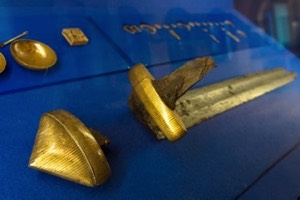 Viking swords are sometimes called Carolingian swords or Carolingian type swords. It is believed that they developed from Vendel type swords, which, in their turn, emerged under the influence of Spatha, a Celtic sword adopted by Roman cavalry along with the Celtic cavalrymen. A universally accepted Viking sword typology was created by Jan Petersen in his 1919 book De Norske Vikingesverd. The sword in the photo above is a type H sword. This type was the most widely spread and had the longest tradition of manufacture. The pommel and the guard of the type H swords were covered with thin bronze, copper or brass plates, which made them look like they were gold. Such swords, in their present condition, are covered with a net of tiny grooves. Modern Viking sword replicas often reproduce these grooves. However, the swords did not look so initially, when they were first created. The grooves appeared as a result of wear-out. The explanation is in the way the plates were fastened to the pommel and the guard. They were covered with the grooves and then the smith hammered the plates into the core steel. Thus when the bronze grew worn and thin, lighter-coloured stripes appeared at the spots where the core steel was the closest to the surface, and grooves began to be formed there.
Viking swords are sometimes called Carolingian swords or Carolingian type swords. It is believed that they developed from Vendel type swords, which, in their turn, emerged under the influence of Spatha, a Celtic sword adopted by Roman cavalry along with the Celtic cavalrymen. A universally accepted Viking sword typology was created by Jan Petersen in his 1919 book De Norske Vikingesverd. The sword in the photo above is a type H sword. This type was the most widely spread and had the longest tradition of manufacture. The pommel and the guard of the type H swords were covered with thin bronze, copper or brass plates, which made them look like they were gold. Such swords, in their present condition, are covered with a net of tiny grooves. Modern Viking sword replicas often reproduce these grooves. However, the swords did not look so initially, when they were first created. The grooves appeared as a result of wear-out. The explanation is in the way the plates were fastened to the pommel and the guard. They were covered with the grooves and then the smith hammered the plates into the core steel. Thus when the bronze grew worn and thin, lighter-coloured stripes appeared at the spots where the core steel was the closest to the surface, and grooves began to be formed there.
Viking sword type according to Petersen is determined after the shape of the sword-hilt. As for the blade itself, the sword in the photo is Ulfberht. The inset inscription reading +VLFBERH+T was a sort of brand or trademark that marked blades of the highest quality. Note that at the period the Roman letter V was used for both modern U and V. The rounded form of the letter first appeared in about the 14th century but even then they wrote V at the beginning of the word, regardless of sound, and U in the middle or end (therefore Shakespearean ‘haue’ and ‘vpon’). Thus the word that we read as Ulfberht, simply could not be written the same way in the Viking Age. Unfortunately, this fact is largely ignored. Secrets of the Viking Sword, a popular 2012 documentary by NOVA, features the rounded shaped U instead of V on their sword replica, which is, I think, a shame.
Ulfberhts were made of a high quality crucible steel, presumably imported from India. Ulfberhts were also often counterfeited by putting a well-known brand on second grade blades. It is not known whether a single master blacksmith or a smith dynasty created all extant Ulfberhts or else this was a kind of quality mark used in several production centers. The word itself is Frankish. Its meaning is not clear. It is suggested that it was a personal name, may be the name of the smith who created the first Ulfberht. There are two explanations that derive the word from stems meaning ‘wolf’ and ‘bear’ or ‘spark’ and ‘shining’. Only about 170 genuine blades of this type are known. Such a weapon could belong to a distinguished warrior.
I took this photo at Novgorod Historical Museum. The caption explained that the sword was a chance find and was dated to the 10th century. As far as I know, it is not published and thus largely unknown. Along other interesting Varangian artifacts, the sword is also featured in my 2014 video recorded in Russia.
Why Norsemen bent or broke the weapons that they put into their burials has never been explained. Two theories suggest that either the swords were put to death ritually so that the weapon would die with its owner or that the blades might have been damaged in order to prevent plunder. In this particular case the damage may be explained by chance mechanical impact like overriding by a caterpillar tractor. Viking swords are often found in farmed fields.
Photo: Ulfberht Viking sword from Novgorod. © The Viking Rune, all rights reserved.

They say that there are legends about this sword, but what are those legends? Do they appear in the sagas?
Arwin, Ulfberht is not a single sword, it was a kind of trademark for high quality swords. I don’t think there are references to Ulfberht swords in the sagas.
They said in the documentary that ulfberht is a Frankish name, but as I know is Ulf a old scandinavian name with the meaning wolf, maybe its comes from Franks, but I can not find any information about that. That makes me wondering,
Languages of the Franks and Scandinavians were both Germanic and had a lot of common features.